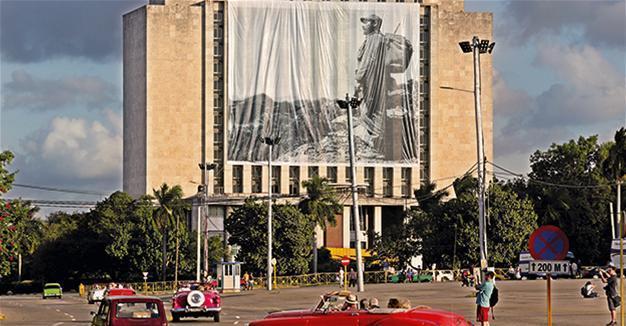Cuba bids farewell to Fidel Castro, ruler for half-century
HAVANA

REUTERS photo
A nine-story portrait of a young Fidel Castro has joined the towering images of fallen guerrillas overlooking Havana’s Plaza of the Revolution, the massive square where Cuba began Nov. 28 to bid farewell to the man who ruled the island for nearly half a century.
After 10 years of leadership by Castro’s younger brother Raul, a relatively camera-shy and low-key successor, Cuba finds itself riveted once again by the words and images of the leader who dominated the lives of generations. Since his death on the night on Nov. 25, state-run newspapers, television and radio have been running wall-to-wall tributes to Fidel, broadcasting non-stop footage of his speeches, interviews and foreign trips, interspersed with adulatory remembrances by prominent Cubans.
“There’s a genuine feeling of mourning, that’s not a formality, that’s not showy, that’s not outward-focused, but rather completely intimate,” former National Assembly President Ricardo Alarcon said on state television Nov. 27.
Ordinary people have largely been staying at home, off streets hushed by a prohibition on music and celebration during the nine days of official mourning for Castro. For some, particularly younger Cubans, Castro’s death barely registered.
Yankemell Barrera, a 20-year-old student, said Castro wasn’t a strong presence in his life and that he wasn’t much affected by his death or planning to go to any of the memorial events. He said studying for finals would be a better use of his time.
“Even if I’m obligated to go, I’m not doing it,” he said.
Tens of thousands of others, though, were expected to return to the streets during Nov. 28, when simultaneous 21-gun salutes were set to sound in the capital and in the eastern city of Santiago, where Castro launched his revolution in 1953.
The government did not say if the ashes of the 90-year-old former president would be on display inside the monument, which will be open for two days for the people to pay their respects. On Nov. 30, Castro’s ashes will begin a three-day procession east across Cuba, retracing the march of his bearded rebel army from the Sierra Maestra mountains to the capital. Castro’s ashes will be interred on Dec. 4, in Santa Ifigenia cemetery in Santiago, Cuba’s second-largest city.
North Korea began three days of official mourning on Nov. 28, for Castro, remembering him as a “close friend” and heroic ally in a joint struggle against U.S. aggression.
Flags flew at half-mast at official buildings across the country as a mark of respect for the revolutionary icon, despite a relationship that was often warmer in rhetoric than reality.
In the Pyongyang subway, commuters in one station crowded around a glass case containing a Castro obituary published by the ruling party newspaper, Rodong Sinmun.
